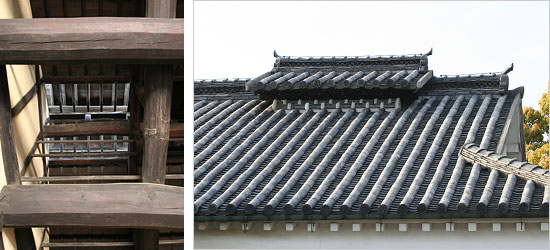|
||
 |
||

Nagatomi
永富 house (Hyougo)
(C)2001 Japanese Architecture and Art Net Users System. No reproduction or republication without written permission.
掲載のテキスト・写真・イラストなど、全てのコンテンツの無断複製・転載を禁じます。
|
||||||
| kemuridashi 煙出 | ||||||
| KEY WORD : architecture / general terms | ||||||
| Also
pronounced kemudashi. A smoke louvre. An opening in the roof of a building
designed to allow smoke from a hearth *irori
囲炉裏 or range *kamado 竈 to escape.
Since the chimney was not introduced from the West until the 19c, smoke louvres
were used in Japanese architecture from the earliest times. They were found in
traditional vernacular houses *minka
民家, in service buildings in upper class residences, temples and shrines, and in
certain proto-industrial structures. The simplest type was an opening in the upper
part of the gable end of a gabled *kirizuma
yane 切妻屋根 or hip-and-gable roof *irimoya
yane 入母屋屋根, often with an open, lattice covering *koushi
格子. It is believed that this type was already in use in prehistoric times (see
*tateana juukyo 竪穴住居).
A more elaborate louvre was the so-called *yagurakemudashi
櫓煙出, which derived name from its resemblance to a turret *yagura
櫓. It had a miniature independent frame with its own roof, either of the kirizuma
or irimoya style, set astride the ridge *mune
棟 of the main roof. Smoke escaped through lattices in the vertical sides of the
frame. Finally, there were kemuridashi set in the sides of the roof. This
louvre resembled a low dormer window frame, such as the *chidori
hafu 千鳥破風 with gabled-roof. Roofing material for kemuridashi usually
matched the building materials of the rest of the structure, though occasionally
tile was used for a kemuridashi on a thatched building. In order that smoke
should make its way up to the kemuridashi, the interior space had to be
at least partially open fukinuke 吹抜け or lofts had to be provided with a
permeable floor of bamboo or timber slats. In some cases, kemuridashi also
served to admit light. |
||||||
 Nagatomi
永富 house (Hyougo)
|
||||||
| REFERENCES: | ||||||
| EXTERNAL LINKS: | ||||||
| NOTES: | ||||||
(C)2001 Japanese Architecture and Art Net Users System. No reproduction or republication without written permission. 掲載のテキスト・写真・イラストなど、全てのコンテンツの無断複製・転載を禁じます。 |
||||||